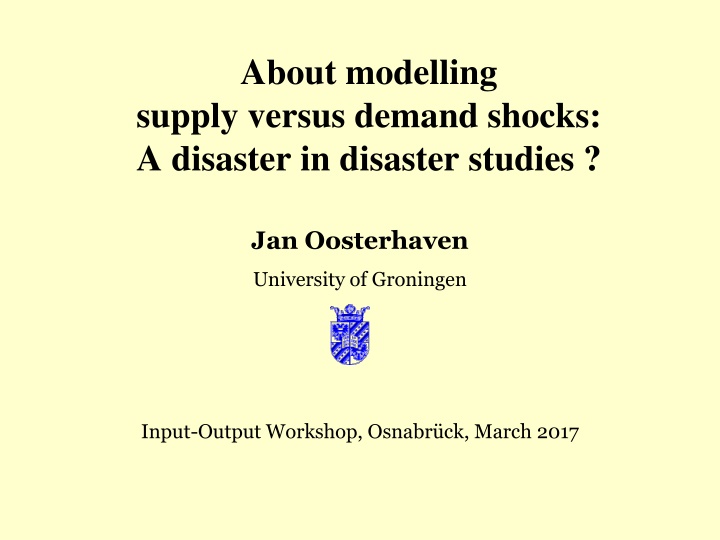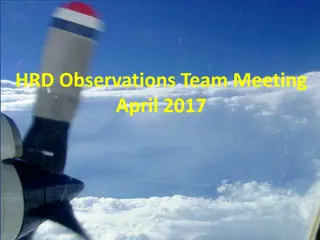
Modelling Supply Versus Demand Shocks: Insights from Disaster Studies
Explore the impact of supply and demand shocks in disaster studies through Ghoshian and Leontief input-output models. Understand the effects of regional supply and demand shocks, along with existing modelling approaches and challenges in interregional analyses. Discover the implications of different economic shocks and the need for improved modelling techniques.
Download Presentation

Please find below an Image/Link to download the presentation.
The content on the website is provided AS IS for your information and personal use only. It may not be sold, licensed, or shared on other websites without obtaining consent from the author. If you encounter any issues during the download, it is possible that the publisher has removed the file from their server.
You are allowed to download the files provided on this website for personal or commercial use, subject to the condition that they are used lawfully. All files are the property of their respective owners.
The content on the website is provided AS IS for your information and personal use only. It may not be sold, licensed, or shared on other websites without obtaining consent from the author.
E N D
Presentation Transcript
About modelling supply versus demand shocks: A disaster in disaster studies ? Jan Oosterhaven University of Groningen Input-Output Workshop, Osnabr ck, March 2017
Basics: demand shock Basics: supply shock Demand shock Demand P P Supply Supply shock Q Q P in same direction P mitigates Q-shock P in opposite direction P mitigates Q-shock CGE models have finite price elasticities. What about IO ?
Ghoshian IO-models Leontief IO-models Supply Demand P-model P-model Demand Supply Q-model Q-model Source: Oosterhaven (Southern Econ. J. 1996) Demand-driven Q-model & Cost-push P-model Infinite supply and zero demand (price) elasticity => No mitigating price-effect Supply-driven Q-model & Demand-pull P-model Infinite demand and zero supply (price) elasticity => No mitigating price-effect
Impacts of disasters and boycotts 1stregional supply shock: direct effect = Loss of capital and labour (- production capacity) Loss of infrastructure or boycott (- trade capac.) => forward: spatial and technical substitution (+), if not replaceable: large forward impacts (-/-) 2ndregional demand shock: direct effect = Loss of intermediate and final demand (-) => backward: further demand reduction (-) Terrorist attack = (spatial) demand shift (-/+)
Existing modelling approaches Ideal: interregional, interindustry CGE model Problem: complex, data hungry => little used Multi-regional IO model: simple => often used Problem: Only OK for short run impacts of final demandshocks/shifts, such as terrorist attacks Intermediate demand shocks => double counting Consumption demand shocks: Type II, same problem Supply shocks: not possible Hypothetical extraction of MRIO cross ? Implicit: combines fixed technical and interregional trade coefficients with full foreign import substitution However, extractedrow = only direct backward impacts, not forward impacts on purchasing industries
Add the supply-driven model for forward impacts? Contradictory to demand-driven MRIO model with its perfectly substitutable single homogenous output Implausible: single homogeneous input => perfect input substitutability: cars without gas, factories without labor ! No: what is needed (Oosterhaven, JRS, 1988): Allocation coefficients from the Ghosh model Reciprocal technical coefficients for irreplaceable inputs Partial import & export substitution for replaceable inputs Our solution: combine some of above elements with Minimum info gain with endogenous MRIOT row and column totals instead of fixed totals (as in RAS), as that simulates Back-to-Business-as-Usual, with max. flexibility
Our NLP modeling approach Actors try to maintain supplier and client relations ( ) rs + , rs ij rs ij rs base ij . ln 1 (1) Min z z z allother MRIOT cells ij Fixed technical coefficients (Walras-Leontief prod.f.) r = = rs ij s s j s j s j s j (2) z a x and v c x ij Fixed preference coefficients (W-L utility function) r = rs i s s (3) y p y i Source: Oosterhaven & Bouwmeester (J. Reg. Sc. 2015)
Demand equals supply (per regional industry) s jz s + + = rs ij rs i r i r i (4) y e x Min. regional consumption ( = disaster-specific) ( ) s r , s s base (5) y y Max. regional value added ( = region-specific) , s s s base (6) v v First test: does(1)-(6) reproduce the base inter- regional IO table ? Yes, for our hypothetical IRIOT
Pre-disaster Interregional IO Table Local final cons. For. Local intermediate consumption R1, I1 R1, I2 R2, I1 R2, I2 Reg. 1 Reg. 2 exports Total R1, Industry 1 15 10 5 6 22 15 27 100 R1, Industry 2 11 29 9 4 68 14 15 150 R2, Industry 1 10 8 35 29 22 49 47 200 R2, Industry 2 6 7 38 43 15 102 39 250 For. imports I1 8 13 16 20 15 21 93 For. imports I2 3 3 6 10 4 7 33 Value added 47 80 91 138 356 Total Other totals: 100 150 Foreign imports 200 250 126 146 208 128 National consumption 354 Source: Oosterhaven & Bouwmeester (J. Reg. Sc. 2015) Next, more important tests: 2 full regional production stops: (1)-(6) + r ix = rs ij 0 i + = rs i 0 ijz y 2 full interregional trade stops: (1)-(6) +
Post-disaster IRIOT after full production stop in Region 2 For. Local final cons. Local intermediate consumption R1, I1 19 14 0 0 13 5 45 95 R1, I2 13 38 0 0 22 5 89 167 Foreign imports R2, I1 0 0 0 0 0 0 0 0 R2, I2 0 0 0 0 0 0 0 0 139 Reg. 1 21 55 0 0 19 4 Reg. 2 21 50 0 0 37 34 exports 21 11 0 0 Total 95 167 0 0 90 49 134 R1, Industry 1 R1, Industry 2 R2, Industry 1 R2, Industry 2 For. imports I1 For. imports I2 Value added Total Other totals: 99 141 32 National consumption 241 Yellow cross & +/+ foreign intermediate imports Hyp. Extract. Extra +/+ domestic intermediate imports in R1 (-/- with HE) Extra +/+ foreign and domestic final imports in R2 (0 with HE)
Post-disaster IRIOT after full production stop in Region 2 For. Local final cons. Local intermediate consumption R1, I1 19 14 0 0 13 5 45 95 R1, I2 13 38 0 0 22 5 89 167 Foreign imports R2, I1 0 0 0 0 0 0 0 0 R2, I2 0 0 0 0 0 0 0 0 139 Reg. 1 21 55 0 0 19 4 Reg. 2 21 50 0 0 37 34 exports 21 11 0 0 Total 95 167 0 0 90 49 134 R1, Industry 1 R1, Industry 2 R2, Industry 1 R2, Industry 2 For. imports I1 For. imports I2 Value added Total Other totals: 99 141 32 National consumption 241 Opposing supply, demand and substitution effects of R2 => R1 => Decrease in output of Industry 1 in R1, larger direct effects -/- => Increase in output of Industry 2 in R1, larger subst. effects +/+ Plus intra-reg. final sales and foreign exports of R1 -/-, to help R2
Conclusion of hypothetical IRIOT Most important assumption not yet mentioned: Prices react such that supply = demand => All changes are measured in base-year prices Findings: a plausible combination of: Demand & supply & spatial substitution effects => partial import & partial export substitution CGE type results without explicit prices/markets Next: real life app. for 2013 German floods
Data: use-regionalized German MRSUT for 2007 Region 1 .. Region r RoW Total Final Demand Final Demand Products Industries Products Industries Product U11 Y11 U1r Y1r e1 g1 Region 1 Industry V1 x1 Product Ur1 Yr1 Urr Yrr er gr Region r .. Industry Vr xr URoW,1 W1 x1 YRoW,1 0 y1 URoW,r Wr xr YRoW,r 0 yr m w RoW GDP g1 gr e Total Source: T bben (PhD, Groningen, 2017)
Elbe & Danube floods of 2013 Basically the same NLP model, but German MRSUT instead of an IRIOT Extra: regional product supply = p. demand Less: min. local final demand = government aid scenario => negative indirect impacts (especially on services) become negligable, -/- trade balance Less: max. local value added = top business cycle scenario => positive substitution effects much smaller => net negative impacts become larger
Sensitivity for fixed ratio assumptions 1. The MRSU model explicitly assumes fixed regional industry market shares in regional product supply, which is mostly implicitly done in IRIO tables 2. The German use-regionalized MRSUT allows assuming cell-specific intermediate and final demand trade origin shares 3. Fixing both ratios together => Type I IRIO & MRSU model assumptions
Impact of adding fixed ratios National and regional 2013 Elbe and Danube flooding multipliers All of Germany Base NLP model 1.110 + fixed market shares 1.193 + fixed trade origins 1.334 + both fixed shares 1.966 Bayern Sachsen Sachsen- Anhalt 1.000 1.010 1.070 1.586 Th ringen 1.139 1.306 1.207 1.588 1.041 1.083 1.176 1.832 1.046 1.057 1.125 1.420 Source: Oosterhaven & T bben (Spatial Econ. An. 2017) Base NLP model: all multipliers small = high resilience Fixed trade origin shares > fixed industry market shares Very large over-estimation of indirect effects with Type I IRIO and MRSU model assumptions
Conclusion and evaluation Outcomes 2013: high resilience of German economy IRIO & MRSU models grossly over-estimate indirect disaster impacts Outcomes NLP spatial substitution CGE, but without explicit prices/markets NLP approach = simple & plausible





















